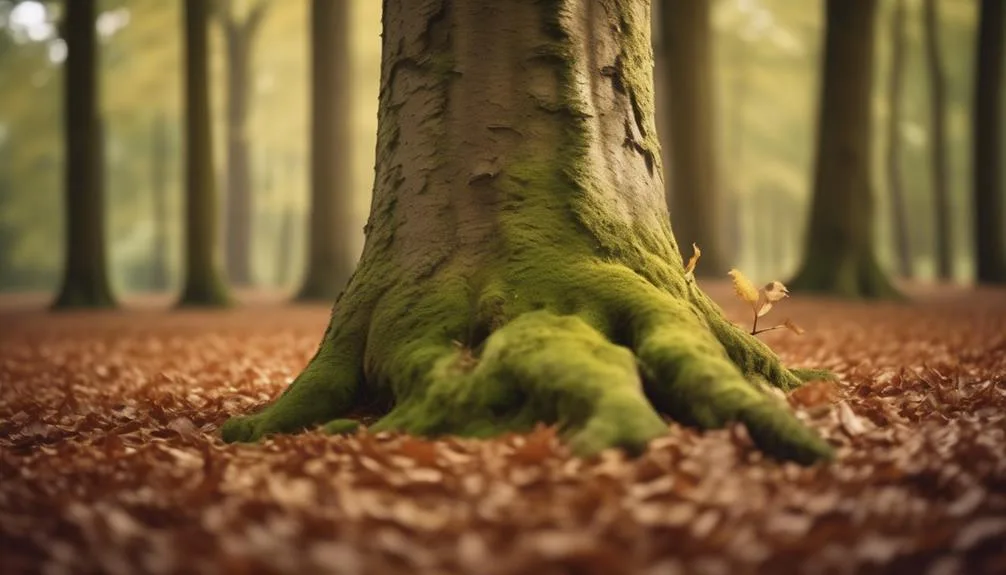Have you ever wondered how fast or slow beech trees grow? It's not a simple answer. Many factors affect their growth rate.
Understanding these factors can reveal insights into the complex world of tree development. As you walk through a peaceful forest, you might have marveled at the grandeur of beech trees.
Their growth is a fascinating subject worth exploring.
Growth Rate of Beech Trees
Beech trees grow at a moderate pace, adding approximately 12-24 inches of new growth each year. This growth rate can vary based on factors such as soil quality, sunlight, and water availability.
Beech tree growth analysis indicates that younger trees tend to grow faster, with growth rates slowing as the trees mature.
Additionally, beech tree growth trends show that these trees typically thrive in well-drained, moist soils with a slightly acidic pH. However, they can also adapt to a range of soil types.
Understanding the growth rate of beech trees is essential for their proper care and maintenance. By recognizing the factors that influence their growth, one can effectively nurture these trees to ensure their healthy development and longevity in various environments.
Factors Affecting Beech Tree Growth
Understanding the various factors that influence the growth of beech trees is crucial for ensuring their healthy development and longevity in different environments. Factors affecting beech tree growth include:
- Soil Quality: The type and quality of soil play a significant role in the growth of beech trees. Well-drained, fertile soils with good aeration are ideal for beech trees, promoting healthy root development and overall growth.
- Climate Conditions: Climate, including temperature, precipitation, and sunlight, directly impacts the growth of beech trees. Beech trees generally thrive in temperate climates with moderate rainfall and well-distributed sunlight. Extreme conditions, such as prolonged drought or severe frost, can hinder their growth.
- Competition: Competition with other vegetation for resources such as water, nutrients, and sunlight can also affect the growth of beech trees, especially in densely forested areas.
Understanding and managing these factors are essential for promoting the healthy growth of beech trees.
Comparing Beech Trees to Other Species
Comparing beech trees with other species reveals distinctive growth patterns and environmental adaptability that set them apart in forest ecosystems.
When comparing growth rates, beech trees are considered moderate to slow growers. In contrast, species such as poplar and willow are known for their fast growth, while oak and maple exhibit moderate growth rates.
Environmental influences play a crucial role in these differences. Beech trees thrive in well-drained, moist soils with a slightly acidic pH, whereas fast-growing species like poplar can tolerate a wider range of soil conditions.
Additionally, beech trees are shade-tolerant, allowing them to grow in the understory of forests, while other species may require more sunlight to thrive.
Understanding these variations in growth and environmental adaptability is essential for effective forest management and conservation efforts.
Tips for Promoting Beech Tree Growth
To promote the growth of beech trees, ensure they're planted in well-drained, moist soil with a slightly acidic pH, and provide adequate shade for their development. Here are some additional tips for promoting beech tree growth:
- Pruning Techniques: Regularly prune dead or diseased branches to encourage healthy growth and shape the tree. Proper pruning can also improve air circulation and sunlight penetration, benefiting the overall health of the tree.
- Soil Fertilization: Consider fertilizing the soil around the base of the beech tree with a balanced fertilizer to provide essential nutrients for growth. This can help support the tree's overall health and vigor, promoting robust growth.
- Mulching: Apply a layer of organic mulch around the base of the tree to conserve soil moisture, regulate soil temperature, and suppress weed growth. This can create optimal conditions for beech tree growth.
Understanding Beech Tree Growth Patterns
As you focus on nurturing the growth of your beech trees through pruning, soil fertilization, and mulching, it's crucial to understand the distinct growth patterns exhibited by these resilient trees. The growth of beech trees is significantly influenced by climate and soil conditions. In colder climates, growth may be slower, while in warmer regions, beech trees tend to grow at a faster rate. Additionally, understanding the root development of beech trees is essential for promoting healthy growth. These trees have shallow, spreading roots that require well-drained soil to thrive. Here's a breakdown of the growth patterns to help you better understand the factors influencing your beech trees' development:
| Growth Factor | Influence |
|---|---|
| Climate | Colder climates may lead to slower growth, while warmer regions can promote faster growth |
| Root Development | Shallow, spreading roots require well-drained soil for healthy growth |
Conclusion
In nurturing beech trees, the pace of growth is influenced by factors like soil quality and sunlight. While typically slow-growing, providing optimal conditions can help them thrive.
Understanding these nuances is key to unlocking their full potential and ensuring their successful development.

My interest in trees started when I first saw the giant sequoias in Yosemite.
I was a teenager then, and I remember thinking, “I need to learn more about this.”
That moment stuck with me.
A few years later, I went on to study forestry at Michigan Tech.
Since graduating, I’ve worked in a mix of hands-on tree care and community education.
I’ve spent over ten years helping people understand how to plant, maintain, and protect the trees in their neighborhoods.
I don’t see trees as just part of the landscape.
They are living things that make a real difference in our daily lives.
